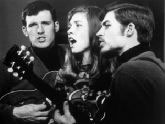If the name the Free Design sounds familiar, but you can’t place why, it’s probably because some of the hippest acts in underground pop—Saint Etienne, the Aluminum Group, High Llamas—are ardent champions of the band, who released seven albums between 1967 and 1973. Japanese cult star Cornelius has reissued several Free Design records on his Trattoria label, and Stereolab even titled a cut on Cobra and Phases Group Play Voltage in the Milky Night after them.
For years, curiosity seekers wondering what all the fuss was about had to settle for a sole domestic CD, Kites Are Fun: The Best of the Free Design (Var賥 Sarabande), or sniff out pricey Japanese imports and vintage vinyl. But now, after a hiatus of nearly 30 years, the Free Design are back. Last year, members Chris, Sandy, and Ellen Dedrick reconvened to cut a version of the Beach Boys’ “Endless Harmony” for the Caroline Now! tribute (Marina), and the folks at the label liked what they heard so much, they asked the Dedricks to make a whole album.
VoilࡠCosmic Peekaboo offers 11 new compositions showcasing Chris, Sandy, and brother Bruce (the original 1966 lineup), plus fourth member Rebecca Pellett, peddling more of the inimitable harmonies and wide-eyed lyricism that permitted the Free Design to spend the Vietnam era waxing happily about subject matter like flying kites, blowing bubbles, and Ouija boards without coming across as the gayest group ever. (Just very close.)
Ensembles singing vocal harmonies, particularly families, are nothing new in pop. Yet compared with ’50s doo-wop groups, squeaky clean ’70s acts like the Osmonds and Starland Vocal Band, or today’s crop of crooning boy bands, the Dedrick clan’s interwoven melodic lines, which cleverly sidestep radio-friendly formulae, remain unparalleled.
According to leader Chris Dedrick, the Free Design’s close-knit sound has always been arranged on paper long before the family enters the studio. “Most of the time, [the music] was completely notated,” he says from Toronto, where today he works scoring for TV and films. Because of that meticulous approach to writing, the Free Design have more in common with ’50s oddballs like the Hi-Los and Mel Torm駳 Mel-Tones than sunny ’60s peers like the Mamas and the Papas and the 5th Dimension.
“The early vocal groups like the Hi-Los—all those arrangements were amazingly well-written,” observes Chris. “The Free Design came along and said, ‘That approach can work in the pop field.’ You can do vocal arrangements that are not necessarily in the jazz or classical style, but still have counterpart, and interesting voicing, and voices going in directions that probably wouldn’t happen off the top of your head.”
And yet for all the care invested in writing the arrangements, clearly informed by his spell at the Manhattan School of Music, Chris correctly surmises that much of the group’s appeal stems from the surprisingly “unaffected” fruits of its labor. “We weren’t putting on any particular affectation of being singers with a certain soloistic style or pop approach,” he observes. “We were coming at it from a naﶥt頴hat maybe is refreshing.”
Although the Free Design never got any higher than No. 114 on the pop charts (with “Kites Are Fun” in 1967), Chris says his new tune “The Hook,” which skewers “all the pretty young singers with their popular songs” and echoes the sharp satire of the band’s earlier “2002—A Hit Song” (it wasn’t), isn’t meant to seem vitriolic.
“I wanted something on the album to be a little bit tongue-in-cheek, ironic, slightly true,” he explains of the song, which couches a catchy melody, reminiscent of Harry Nilsson, in some of Cosmic Peekaboo‘s most challenging harmonies. “I’m spoofing myself as much as anybody else. It is just what it is—a fun song about one aspect of how [the music business] is. It’s kind of unfortunate how you could be a really great singer, but if you’re not great looking and don’t get the right machinery behind you, you’ll have to do something on an independent level.”
Contrasted with today’s groomed and polished pop products, the Free Design still sounds naive, even if Chris and Bruce’s new lyrics are slightly older-and-wiser in character. Despite the onset of gray hair, Chris says maintaining the almost childlike innocence that distinguishes the band’s songs and makes Cosmic Peekaboo as refreshing as any of the group’s original output has never been a challenge.
“Music has its place as a reflection of everyday life and what’s going on,” he concludes. “But when it comes to songwriting, my major emphasis is that music has its roots in the less temporal, in higher ideals. And somehow, I’ve never had to strive to keep music in that place. That’s where it belongs, and that’s the music I love most: Music that transcends anything that can have to do with time and familiarity and politics.”






